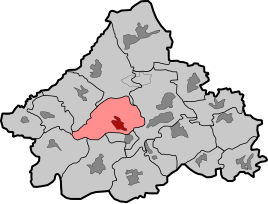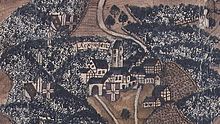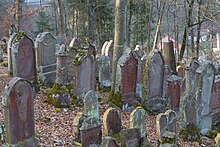Rexingen (Horb)
|
Rexingen (Horb)
City of Horb am Neckar
|
|
|---|---|
| Coordinates: 48 ° 26 '27 " N , 8 ° 38' 59" E | |
| Height : | 478 m above sea level NHN |
| Area : | 7.16 km² |
| Residents : | 1280 (December 31, 2014) |
| Population density : | 179 inhabitants / km² |
| Incorporation : | July 1, 1971 |
| Postal code : | 72160 |
| Area code : | 07451 |
|
Location of Rexingen (Horb) in Horb am Neckar
|
|
Rexingen is a district of the town of Horb am Neckar in the Freudenstadt district in Baden-Württemberg .
geography
Rexingen is located about 60 kilometers southwest of Stuttgart and is embedded in a side valley of the Neckar and is a district of the city of Horb am Neckar in Baden-Württemberg with 1255 inhabitants and an area of around 7.16 km² .
Economy and Infrastructure
traffic
Rexingen is connected to the federal highways 14 and 28a . The closest larger towns are Horb, Sulz am Neckar , Nagold and Freudenstadt . The village is connected to the bus network of the Verkehrs-Gemeinschaft Landkreis Freudenstadt (VGF) and has direct bus connections to Horb, Freudenstadt and Waldachtal .
The nearest train stations are in Horb and Bittelbronn . There used to be the Altheim / Rexingen stop on the Eutingen railway in the Gäu – Freudenstadt , but it is no longer served.
The closest neighboring town of Ihlingen is about a kilometer southeast of Rexingen.
media
The Black Forest Bote from Oberndorf and the Südwest-Presse from Ulm are represented as local daily newspapers in Rexingen . In addition, the “Mitteilungsblatt der Stadtteile Rexingen and Ihlingen” is published once a week.
history
The name of the place developed from the personal name "Raciso" via "Raggesingen" to "Rexingen".
The Johanniter - / Malta founded in 1275 in a Rexingen Coming . The Kommende Rexingen belonged to the Catholic Grand Priory of Germany of the Order of St. John / Maltese until 1806, with its seat in Heitersheim . After 1806 Rexingen became a castle property of the King of Württemberg .
On the crest that's Maltese Cross to see. It used to be the cross of the Order of St. John / Maltese. At that time, today's coat of arms served as the stamp of the order. It has been used as a coat of arms since around 1934.
Jewish community
For 300 years since the Thirty Years War there was a Jewish community in the city , which was initially under the protection of the Johanniter / Maltese and at times made up half of the population. In 1932 the Jewish population of Rexingen had shrunk to a few hundred. A third of them were victims of the extermination camps , ten families and several unmarried young men (adopted on February 6, 1938 in the Rexingen Synagogue) succeeded in emigrating in 1938/39, mainly to Palestine and the United States . Jews from Rexingen founded the moshaw Shawei Zion .
The former Rexingen synagogue survived the Nazi era and is now a memorial and at the same time a Protestant church. The Jewish cemetery is also a memorial.
Incorporation
On July 1, 1971, Rexingen was incorporated into the town of Horb am Neckar.
Culture and sights
synagogue
The first synagogue in Rexingen was built in 1712.
The present synagogue was built 125 years later in 1837. During the pogrom night of November 9-10 , 1938, it was set on fire by Nazi supporters. The building was saved by the fire department, but the church was completely burned out inside.
In the following war years, the synagogue served as a storage room for the Mauser weapons factory . Today it is also known under the name " Evangelical Church " and is used as such. A memorial room inside the church provides information about this story.
Jewish Cemetery
The Rexingen Jewish cemetery represents almost 300 years of history of a former Jewish community. 931 gravestones from the period from 1765 to 1942 (last burial in the Israelite rite) tell of the heyday of Jewish culture in Württemberg. The cemetery was laid out in 1760 and expanded until 1914.
After the Second World War , it was renovated and has been regularly maintained ever since. Since 1947 a memorial stone has commemorated at least 70 Jewish victims of the Shoa from Rexingen. A large number of those who were able to emigrate in time settled in the Israeli Shaei Zion. A memorial hall there has been commemorating the murdered Rexingen Jews since 1968.
monument
The monument was built in 1933 and inaugurated in 1937. It was a reminder of the National Socialists' seizure of power in the form of a swastika . Shortly before the end of the war (1945), the swastika was overturned and the stone tablets with National Socialist symbols were broken off. In 1952 a Christian cross was placed on the pillar by the village of Rexingen and the gaps in the torn stone tablets were closed with cement surfaces . In 2003, volunteers renovated the monument again.
Personalities
- Isidor Hirschfelder (1878–1941), doctor
- Josef Zürndorfer (1888–1915), fighter pilot
- Hermann Kinkele (1892–1956), mayor, Catholic and pacifist
- Herbert Fröhlich (1905–1991), engl. Physicist of German origin
Individual evidence
- ^ Large district town of Horb am Neckar: Rexingen. (No longer available online.) In: www.horb.de. Formerly in the original ; Retrieved March 27, 2011 . ( Page no longer available , search in web archives ) Info: The link was automatically marked as defective. Please check the link according to the instructions and then remove this notice.
- ↑ Kehrwoche in Shavei Zion in Chrismon 08.2011, page 12-19
- ^ Federal Statistical Office (ed.): Historical municipality directory for the Federal Republic of Germany. Name, border and key number changes in municipalities, counties and administrative districts from May 27, 1970 to December 31, 1982 . W. Kohlhammer, Stuttgart / Mainz 1983, ISBN 3-17-003263-1 , p. 529 .
- ^ The synagogue in Rexingen (City of Horb am Neckar, Freudenstadt district). In: www.alemannia-judaica.de. March 8, 2009, accessed on April 19, 2009 : “During the November pogrom in 1938, the synagogue was demolished and set on fire by SA people. Victor Neckarsulmer, who hurried to the synagogue, reported: “The synagogue was burning in various places. SA men tore lamps and memorial plaques for the deceased from walls and basins. Hatchets, benches and Torah scrolls were beaten with hatchets and axes. At that point in time I was still of the opinion that it would be an individual action ... Then I went to Mayor Gunkel. With all sorts of excuses he tried to cover up the real reasons ... When I got back to the synagogue, the building was still standing, but the church was completely burned out. What was left was piled up in a corner in the synagogue courtyard and set alight again. For example the Torah scrolls, prayer books ... On the way to my house I was arrested and taken to the prison in Rexingen ... “Neckarsulmer was taken to Dachau. After his release and return to Rexingen, the local hunter handed him a Torah scroll that he had rescued from the ashes in front of the synagogue: “Today this Torah scroll, a little burnt, a bit stabbed with knives, but otherwise well preserved, in the Rexinger memorial room in Shavei Zion set up "."
- ↑ a b Ulrike Puvogel: Memorials for the Victims of National Socialism: a Documentation . Ed .: Federal Agency for Political Education. tape 1 . Bonn 1995, ISBN 3-89331-208-0 , pp. 49 .
- ↑ Renate Karoline Adler, Nina Michielin (Red.): Traces of life on the Jewish cemetery in Rexingen, carved in stone . In: Stadtarchiv Horb (ed.): Jewish cemeteries in the city of Horb . tape 1 . Theiss, Stuttgart 1997, ISBN 3-8062-1296-1 .
literature
- Günther and Leslie Petzold: Shavei Zion. Blossom in Israel from Swabian roots. 2nd A. 1985, ISBN 3-88350-305-3
- Heinz Högerle, Carsten Kohlmann, Barbara Staudacher (eds.): Place of refuge and promise. Shavei Zion 1938-2008. Theiss, Stuttgart 2008, 280 pages. ISBN 978-3-8062-2141-1 (catalog for the exhibitions in Rexingen (February 10, 2008 to March 9, 2008), about the unique group emigration of Rexingen Jews and the establishment of Shavei Zion in 1938).
Web links
- Official Rexingen website at www.rexingen.info and at the large district town of Horb www.horb.de
- Johanniterkommende Rexingen in the database of monasteries in Baden-Württemberg of the Baden-Württemberg State Archives









